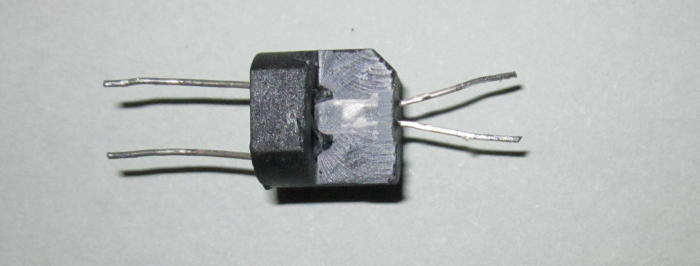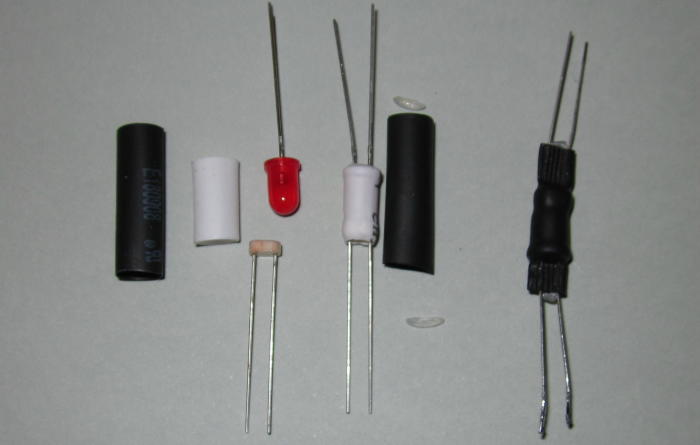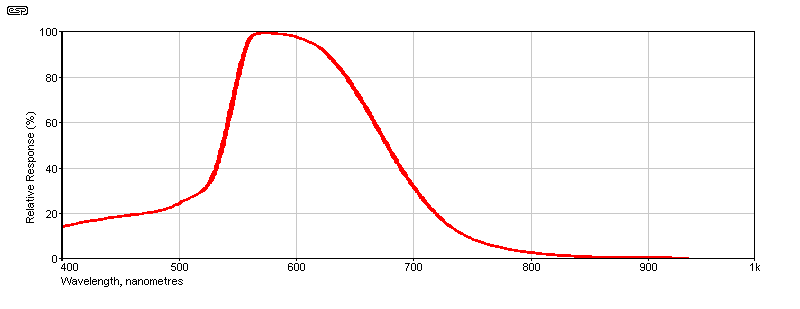

|
| Elliott Sound Products | Project 200 |
This isn't a 'real' project in the proper sense of the term, but has been 'migrated' from Project 145 because it's useful in its own right. I've separated this section of the original article to ensure that it is presented in the best way. Vactrols (LED/LDR optocouplers) are still available from some suppliers, but where they were once quite common, many suppliers no longer stock any similar devices.
Because they are so useful, there are plenty of good reasons to keep the (relatively ancient) technology alive. A Vactrol makes an excellent peak limiter, and they have been used in some of the best-regarded compressor/ limiter products. I've shown several projects that use them, for anything from peak limiting to 'noiseless' switching circuits. Although it's not something I've relied on in any project, commercial versions offer extremely high isolation voltage (typically 2kV).
The VTL5C2, VTL5C3, VTL5C4, NSL32 and its ilk are not inexpensive and are often hard to locate, because they aren't a 'normal' stock item for most suppliers. If you can't get one, or just prefer to 'roll your own' optocouplers, then this is for you. You will need to obtain a suitable quantity of LDRs and some 5mm red LEDs. You can use other colours, but red seems to be the most common. You will also need black heatshrink tubing, and the dual-wall type (with hot-melt adhesive inside) is worthwhile because it makes sure that the crimped ends remain light proof and it binds the LED and LDR firmly in place.
It is very important to ensure that the LED shines directly onto the LDR to obtain maximum coupling efficiency, which in turn means that you can run the LEDs are a lower current. If you wanted to, you could even file the end of the LEDs flat and use transparent glue to bind the LED and LDR together. The photo below shows a DIY optocoupler made this way, and I built a couple so that they could be compared directly against the Vactrol VTL5C4 optocouplers I have in stock. Yes, they work perfectly.

Figure 1 - Schematic Symbol For A Vactrol™ (DIY Or Original)
For reference, I attacked a VTL5C4 in my milling machine to produce a cutaway of the insides. The LED is quite obvious, and the LDR is inside the section that isn't removed. The LED is intact and shows normal forward voltage drop, but no visible light could be seen when it was powered. This indicates that the LED is actually infra-red, and the low forward voltage of 1.5 V using the diode test facility in my bench multimeter tends to confirm this. A red LED (as shown below) measured 1.65V with the same meter. Feel free to use an IR LED if you prefer, but I've not tested this combination. There's more information about the optimum LED colour in the next section. Use of a high-brightness red LED is recommended, as it needs much less current than a 'normal' LED for the same light output.

Figure 2 - Cutaway View Of Vactrol VTL5C4
In the photo below, on the left you can see the component parts. I included the white heatshrink to reflect as much light as possible back to the LDR, but I don't think it really makes that much difference. Feel free to use it or not. In the centre you can see the partially assembled optocoupler, and the two small blobs at each end of the black heatshrink are small pieces of hot-melt adhesive. These are inserted into the ends of the black heatshrink after initial heating. Once the glue is in place, heat the end and squeeze closed with pliers.
If you have the facilities to do so, it may help if you grind or file the end of the LED so it's flat, ensuring better light transfer. If you do this, make sure that you don't remove so much of the LED's curved front that the LED junction is exposed or damaged. I don't think it makes a great deal of difference, especially if you use white heatshrink tubing to hold the LED and LDR together, then cover the assembly with black heatshrink to keep out external light.

Figure 3 - DIY Optocoupler Components & Assembly
The finished isolator is shown at the right, and you can see a small amount of hot-melt that was squeezed out when the heatshrink was closed up while still hot. You can see from the solder on the LED leads that this unit was tested, and it performs almost exactly the same as a genuine Vactrol, but at a fraction of the cost. Of course, the assembly takes time, and would not be economical in production. The home-made version is also quite a bit longer than a Vactrol so it takes up more space on a PCB or Veroboard. However, it also has a much smaller diameter, so the relative sizes probably balance out fairly well. The red LED shown is not optimum for the LDR (see below), but it works well enough in practice.
It's very important to ensure that the 'enclosure' is light-tight. If ambient light can get into the circuit, the LDR will reduce its maximum resistance, and that may cause your circuit to malfunction. Black heatshrink seems to be very good in the tests that I've done, but you can use two layers if you expect your version to be subjected to very bright light (such as sunlight). If at all possible, direct sunlight should be avoided.
The ideal LED is matched to the LDR that you have, and provided you can get information (by using the part number) you can work out the LED colour that best matches the LDR. All LDRs have an optimum wavelength, and some include a graph that shows sensitivity vs. wavelength, and from that you can work out the colour. In other cases, only the wavelength for peak sensitivity is given, without a graph.

Figure 4 - The Visible Spectrum
I have datasheets for a couple of different LDRs, the NSL19-M51 (550nm) and the P1241-05 (560nm). The latter were purchased as a 'stock overflow', so I have a bag full of them. As noted, their sensitivity peaks at 560nm, and the response of a more-or-less typical LDR is shown below. This can be compared to the chart in Figure 4 to see what colour is best. For most LEDs where I've been able to find a datasheet, the best match is between green and green/yellow. A blue LED is the worst possible choice, as response drops off quite quickly at wavelengths shorter than the ideal.

Figure 5 - Spectral Response Of Perkin Elmer (Type 0 Material at 25°C) LDR
Some (such as the NSL19-M51) don't include a graph, but the optimum spectral sensitivity is (nearly) always quoted. If you compare both to the visible spectrum, it shows that they will respond best with a green or amber LED. Green has have a wavelength of about 550nm, and amber is around 600nm. LED colours are normally not overly precise. As an example, a Kingbright L-53GD green LED has a claimed wavelength of 568nm. This is a 'standard' round, through-hole LED, 5mm diameter. Most green LEDs are similar, ranging from 560 to 570nm, but a small variation shouldn't cause any problems (I've used them with red LEDs and got good results!). That may reduce the sensitivity to around 75% of the maximum, but that's less than a 3dB difference, and a bit more LED current easily compensates. Most red LEDs are around 625nm wavelength.
To get the maximum possible performance, the LED and LDR should have roughly equal wavelengths, which will require checking datasheets to find a good match. It usually doesn't matter very much is there's a small discrepancy, but the closer you get, the more sensitive your optocoupler will be. If in doubt, just use a high-brightness red LED.
 Main Index
Main Index
 Projects Index
Projects Index